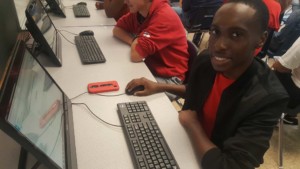Success in Algebra Requires Deeper Learning

Algebra holds a lot on its shoulders. It is often referred to as the gateway to a successful math journey and for many it is the first time that math gets really really difficult. Pair that with all of the goodness that comes from middle school/early high school and you get a lot of pressure on a subject that has the potential to be one of the most memorable and powerful classes of a student’s school career (that is coming from a former algebra teacher, so saying this with a 100% bias).
With all of its difficulty and real world relevance, Algebra is also prime for Deeper Learning. In this blog that first appeared on the DreamBox Learning Blog, Tim Hudson, Senior Director of Curriculum Design at DreamBox Learning, a Getting Smart Advocacy Partner, takes the lens of deeper learning and applies it to his own math classroom. He shares an “aha” moment of his own that led him to create classroom experiences that allowed students to actively participate — to think on their own and to design their own solutions to problems.
Algebra can absolutely “make sense” to students, we just have to let them engage in real ways and Deeper Learning is a huge part of making this happen.
Tim Hudson
The Reality of Learning Gaps in my Classroom
The first year I taught tenth grade Geometry, I gave my students a bonus* problem on the final that required them to use what they had learned the year before in Algebra 1 about distance, rate, and time. In short, my students had to determine whether it was faster to travel 49 km at a rate of 50 kph or to travel 41 km at a speed of 40 kph.
The only thing more shocking than how few students correctly figured out the answer was how most students had written only “d = rt” on their test. They had clearly remembered a useful formula, but apparently knew nothing about what it meant or how to apply it in even the simplest of problems. In nearly every case, there were no eraser marks or any other indication that students had even tried to figure out how to use the formula. It might be that they just gave up because it was a “bonus” and therefore thought the answer might be unattainable. But given the simplicity of the question, I’m still surprised so many gave up or didn’t even attempt to solve the problem.
The Lens of Deeper Learning Applied to Math Classrooms
Looking back on what our math department did to improve algebra readiness and understanding for all of our students, I think principles based on Deeper Learning would have been helpful. The Deeper Learning framework provides some key insights for middle school and Algebra 1 teachers about how to prevent the student proficiency problem I witnessed as a Geometry teacher. Specifically, math teachers should focus on the second element of Deeper Learning:
Critical Thinking and Problem Solving: Students think critically, analytically, and creatively. They know how to find, evaluate, and synthesize information to construct arguments. They can design their own solutions to complex problems.
All math teachers will tell you they want students to be critical thinkers and problem solvers. Yet we see plenty of evidence that most students are not performing as well as we would hope. Given that only about one-third of eighth graders in the US are proficient in math, and that over 60% of community college students are required to enroll in developmental math courses, it seems clear that our current practices are not improving student thinking and problem-solving ability in mathematics.
One reason for this disconnect between our goals and reality is that the last element of the Deeper Learning description above is often lacking in math classes, including Algebra 1: Students can design their own solutions. How often in our math courses are students given time and opportunity to design their own solutions to any math problems—whether simple or complex? As an example, most adults have difficulty remembering much from their math courses. They often recall things like “PEMDAS,” “Carry the one,” “Isolate the variable,” “Bring down a zero,” “FOIL,” “Invert and multiply,” and “DIRT (d = rt).” Though most adults recall or recognize these things from school, they typically remember or understand very little about what each of them mean mathematically, much like my Geometry students on the final.
The Need for Students to Design Solutions in all Classrooms
Using the lens of Deeper Learning, the reason why each of these shortcuts and acronyms does not improve students’ critical thinking and problem-solving ability is that these aren’t solutions that were designed by students. Students are being provided with answers to questions they have never asked, and being given strategies for solving problems they don’t fully understand. From a student’s point of view, these are all solution strategies designed by someone else from a position of advanced expertise. And in many cases, these shortcuts are actually incorrect and can inhibit student transfer as has been documented in the books Nix The Tricks, Young Mathematicians at Work, and others.
To ensure student success in Algebra 1 and beyond, students need to think on their own and design their own solutions to problems. Often, people oversimplify this approach by calling it “discovery learning,” which seems to communicate that we need each student to re-invent the mathematical wheel for every concept and skill in the curriculum. In reality, better ways to describe the Deeper Learning solution design process are “making sense,” “understanding,” or “deeper learning.” What might look to an adult as “reinventing” is actually “sense-making” in the mind of the learner. Our job as educators and curriculum developers is to ensure students are on an appropriate learning pathway to hone their strategies and improve their efficiency. A New York Times piece called “The Problem With Math Problems: We’re Solving Them Wrong” has great advice from Tracy Zager, Steven Strogatz, and Christopher Danielson that can help parents and teachers support the learning process.
The Power of Independent Critical Thinking in my Classroom
I have no doubt that if my tenth graders had spent more time in ninth grade designing their own solutions to problems involving distances and rates, they would have actually understood and been able to apply not only d = rt but also d ÷ r = t and r = d ÷ t. That genuine understanding would not have been forgotten in a year’s time, and they would have quickly and easily solved my bonus final exam question.
Though most students missed that bonus problem on my final, I was proud to have one student to whom I gave full bonus credit even though he didn’t show me any work. After writing “I don’t know the answer,” he wrote a short note thanking me for a great year in Geometry and wishing me a fun summer. But after signing off, he wrote a P.S.: “Now that I think about it, both trips will be just about an hour long. But traveling 49 km at 50 kph will get you there faster—in a bit less than an hour.” As a teacher, my goal is to make sure every student has enough time, opportunity, and engagement to honestly say, “Now that I’ve thought about it.”
* Even though they were supposed to have learned how to solve this type of problem in Algebra 1, I considered it a bonus problem in Geometry because I had never introduced a problem like it in class. Given the Geometry curriculum, it would not have been fair or transparent to hold students accountable for that learning outcome.
Interested in the idea of making mathematics thought-provoking rather than mind-numbing? Vote for Tim’s SXSWEdu session: Middle School Math: Moving from Agony to Awesome!
Each year, to encourage attendee involvement and allow a shared session selection process, SXSWEdu opens up session submissions for voting through their Panel Picker website. For more on sessions from Tim and the DreamBox Learning team, check out Data? PD? Middle School Math? Oh, my!
For more, check out:




Kenneth Tilton
Faster is faster, and 50kph is faster than 40kph. Yes, it takes longer, but I am going further, so it takes longer. I think you meant "sooner" or "in less time".
I do not mean this as a quibble. Your challenge to the kids was great, but it requires precision of the inquisitor as well.
Anyway, your larger point is valid. Feynman found the same in his visiting professorship in South America. Students parroting formulae well but unable to connect it to light reflecting off the bay outside (or something like that).
But with the CCSS authors you miss that many students will be able to master the procedures and of them many will then see more deeply, but in truth this deeper thing targets only the most apt, who need little help anyway going deeper.